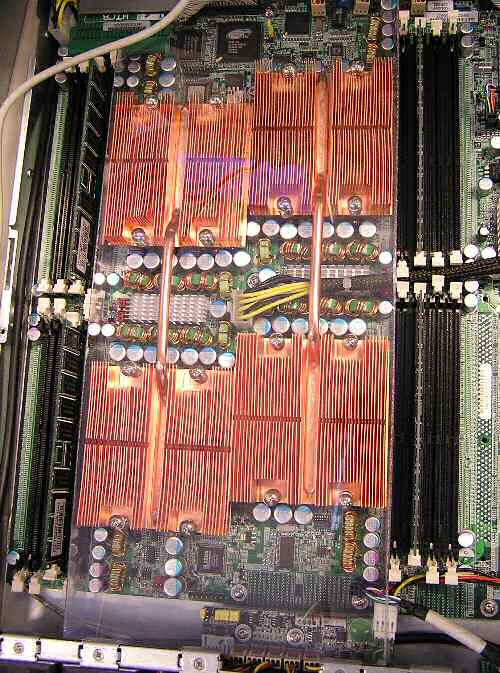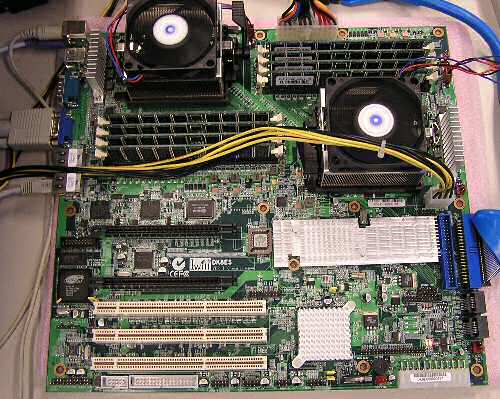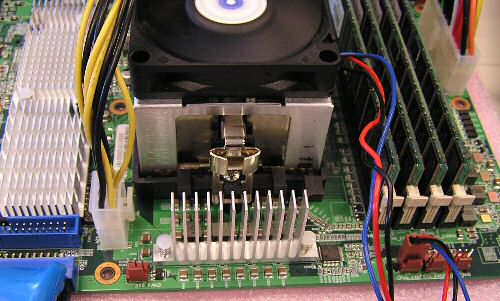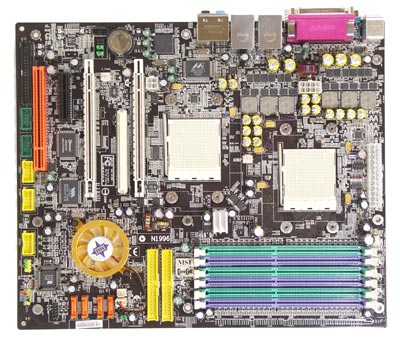Linux Database Server CPU Comparison
by Johan De Gelas on June 17, 2005 12:05 AM EST- Posted in
- IT Computing
Words of thanks
A lot of people gave us assistance with this project, and we like to thank them of course:David Van Dromme, Iwill Benelux Helpdesk (http://www.iwill-benelux.com)
Ilona van Poppel, MSI Netherlands (http://www.msi-computer.nl)
Frank Balzer, IBM DB2/SUSE Linux Expert
Jasmin Ul-Haque, Novell Corporate Communications - SUSE LINUX
Matty Bakkeren, Intel Netherlands
Trevor E. Lawless, Intel US
Larry.D. Gray, Intel US
Markus Weingartner, Intel Germany
Nick Leman, MySQL expert
Bert Van Petegem, DB2 Expert
Ruben Demuynck, Vtune and OS X expert
Yves Van Steen, developer Dbconn
Damon Muzny, AMD US
I would also like to thank Lode De Geyter, Manager of the PIH, for letting us use the infrastructure of the Technical University of Kortrijk in which to test the database servers.
Benchmark configuration
To ensure that our databases were stable and reliable, we followed the guidelines of SUSE and IBM. For example, DB2 is only certified to run on the SLES versions of SUSE Linux - you cannot run it - in theory - on any Linux distribution. We also used the MySQL version (4.0.18) that came with the SUSE SLES9 CD's, which was certified to work on our OS.Network performance wasn't an issue. We used a direct Gigabit Ethernet link between client and server. On average, the server received 4 Mbit/s and sent 19 Mbit/s of data, with a peak of 140 Mbit/s, way below the limits of Gigabit. The disk system wasn't overly challenged either: up to 600 KB of reads and at most 23 KB/s writes. You can read more about our MySQL and DB2 test methods.
Software:
IBM DB2 Enterprise Server Edition 8.2 (DB2ESE), 32 bit and 64 bitMySQL 4.0.18, 32 en 64 bit, MyISAM and InnoDB engine SUSE SLES 9 (SUSE Entreprise Edition) , Linux kernel 2.6.5, 64 bit.
Hardware
We'll discuss the different servers that we tested in more detail below. Here is the list of the different configurations:Intel Server 1:
Dual Intel Nocona 3.6 GHz 1 MB L2-cache, 800 MHz FSB - Lindenhurst Chipset
Dual Intel Irwindale 3.6 GHz 2 MB L2-cache, 800 MHz FSB - Lindenhurst Chipset
Intel® Server Board SE7520AF2
8 GB (8x1024 MB) Micron Registered DDR-II PC2-3200R, 400 MHz CAS 3, ECC enabled
NIC: Dual Intel® PRO/1000 Server NIC (Intel® 82546GB controller)
Intel Server 2:
Dual Xeon DP 3.06 GHz 1 MB L3-cache, Dual Xeon 3.2 GHz 2MB L3-cache
Dual Xeon 3.2 GHz
Intel SE7505VB2 board - Dual DDR266
2 GB (4x512 MB) Crucial PC2100R - 250033R, 266 MHz CAS 2.5 (2.5-3-3-6)
NIC: 1 Gb Intel RC82540EM - Intel E1000 driver.
Intel Server 3:
Pentium-D EE 840
Intel SE7505VB2 board - Dual DDR266
2 GB (4x512 MB) Crucial PC2100R - 250033R, 266 MHz CAS 2.5 (2.5-3-3-6)
NIC: 1 Gb Intel RC82540EM - Intel E1000 driver.
Opteron Server 1: Dual Core Opteron 875 (2.2 GHz), Dual/ Single Opteron 850, Dual/Single Opteron 848
Iwill DK8ES Bios version 1.20
4 GB: 4x1GB MB Transcend (Hynix 503A) DDR400 - (3-3-3-6)
NIC: Broadcom BCM5721 (PCI-E)
Quad Opteron Server 2: Iwill H4103: Quad Opteron 844, 848
Iwill H4103
4-8 GB: 4-8x1GB MB Transcend (Hynix 503A) DDR400 - (3-3-3-6)
NIC: Intel 82546EB (PCI-E)
Opteron Server 3: Dual Core Opteron 875 (2.2 GHz), Dual/ Single Opteron 848
MSI K8N Master2-FAR
4 GB: 4x1GB MB Transcend (Hynix 503A) DDR400 - (3-3-3-6)
NIC: Broadcom BCM5721 (PCI-E)
Opteron Server 4: AMD Quartet: Dual Opteron 848, Quad 848
Quartet motherboard, Zildjian personality board, Tobias backplane board and Rivera power distribution board.
Quad configurations: 4 GB: 8x512 MB infineon PC2700 Registered, ECC enabled
Dual configurations: 2 GB: 4x512 MB infineon PC2700 Registered, ECC enabled
NIC: Broadcom NetExtreme Gigabit
Client Configuration: Dual Opteron 850
MSI K8T Master1-FAR
4x512 MB infineon PC2700 Registered, ECC enabled
NIC: Broadcom 5705
Shared Components
1 Seagate Cheetah 36 GB - 15000 RPM - 320 MB/s
Maxtor 120 GB DiamondMax Plus 9 (7200 RPM, ATA-100/133, 8 MB cache)
Software
Vtune for Windows version 7.2, Vtune for Linux remote agent 3.0Code Analyst for Linux 3.4.8
Code Analyst for Windows 2.3.4
More about the servers in this test
Although our main focus is the database server performance of the different AMD and Intel platforms, allow me to introduce some of the motherboards and server barebones that we used in this test.Iwill H4103
The amount of power that the Iwill H4103 can pack in a 1U rack mounted case is nothing short of amazing. As you can see, there are no less than 4 Opterons in this pizza box, which also allows you to put up to 32 GB of DDR RAM in there. Even more impressive is the inclusion of two redundant 700 Watt power supplies.


What about cooling? Well, this is a server of course and a whole battery of 10,000 RPM fans keep the copper heat sinks cool. In our poorly cooled lab, temperatures rose easily to 30°C and higher, but the Iwill H4103 heat sinks hardly became warm under full load. According to Iwill, you should be able to use dual core Opterons in this pizza box, but we haven't been able to verify this as the necessary BIOS version still had yet to arrive.
The H4103 left a very stable and highly performing impression upon us. The only thing left that would make this ultra compact quad Opteron machine complete is the integration of a SCSI controller or at least a very good SATA controller.
Iwill DK8ES
The Iwill DK8ES is a server board, based on NVIDIA's nForce 4 2200 Professional chipset, which includes two x16 PCI Express slots. The board also integrates an ATI RageXL VGA controller, 2 x PCI-Express x16 expansion slots (one in PCI-Express x2 mode), 3 PCI-X 64bit 133/100/66MHz expansion slots and 4 SATA ports. Two Broadcom BCM5721PCI-E Gigabit Ethernet Controllers are connected to a PCI-E port.

The board has proven to be fully stable during 6 weeks of heavy database server testing. The only problem was that Linux didn't like running Dual core Opterons on this board. A BIOS update (to 1.20) made the Opteron 275 and 875 run stable on this board, but Linux (kernel 2.6.12) still didn't use both cores. Both cores were reported, but only one was used. We suspect that Iwill may have to work out a BIOS issue, or that some of the NVIDIA Linux drivers still need some tuning.
MSI's K8Master-FAR2
MSI sent us a completely different, relatively cheap workstation board that should enable very compact quad core (two dual cores) Opteron machines. The MSI K8Master-Far2 is based on the NVIDIA nForce 4 Pro chipset.In order to get two Opteron sockets, one 32-bit/33 MHz PCI slot, one PCI Express x4 slot and two PCI Express x16 slots (SLI mode supported) on a standard ATX board, MSI didn't give the second CPU local memory. Despite this limitation, the MSI K8Master-FAR2 proved to be an excellent performer in our database server tests.
Six memory slots allow up to 12 GB of RAM, not bad for such a compact board.

But at the end of the tests, the MSI K8Master-FAR2 (BIOS version 1.0) proved to be a very capable board. Supported by our Vantec 470W power supply, it had no trouble at all with two 875 Opterons running heavy database server tests for more than 3 weeks.










45 Comments
View All Comments
imaheadcase - Friday, June 17, 2005 - link
Wow that was a great Anandtech article. Pictures are good for those not to bright! numbers for those smart folks! :PGood article all jokes aside.
bersl2 - Friday, June 17, 2005 - link
#3: The thing is, that the effectiveness of optimization flags is dependent on the application being used (specifically, what the application is doing and how it is designed). Activating the wrong optimization can have adverse effects on performance.I would say that -march=xxx is always helpful, -O and -Os are always helpful, -O2 is almost always helpful, -ffast-math is usually helpful, and you should hold your breath on most anything else. You can also try Acovea (http://www.coyotegulch.com/products/acovea/index.h... which applies a genetic algorithm to compiler flags. Just don't expect to come out ahead, given the number of compiles you have to perform for such a small amount of performance.
hondaman - Friday, June 17, 2005 - link
I'm quite surprised at the poor showing by gentoo vs suse. What compile flags where used out of curiousity?Not that I'd ever use gentoo again. Traitor. :(
Zebo - Friday, June 17, 2005 - link
If you mean AMD dominates benchmarks and applications server, desktop, and worksation wise then everything is "pro AMD"Quanticles - Friday, June 17, 2005 - link
SUSE is very pro AMD, I guess it's worked out. =)